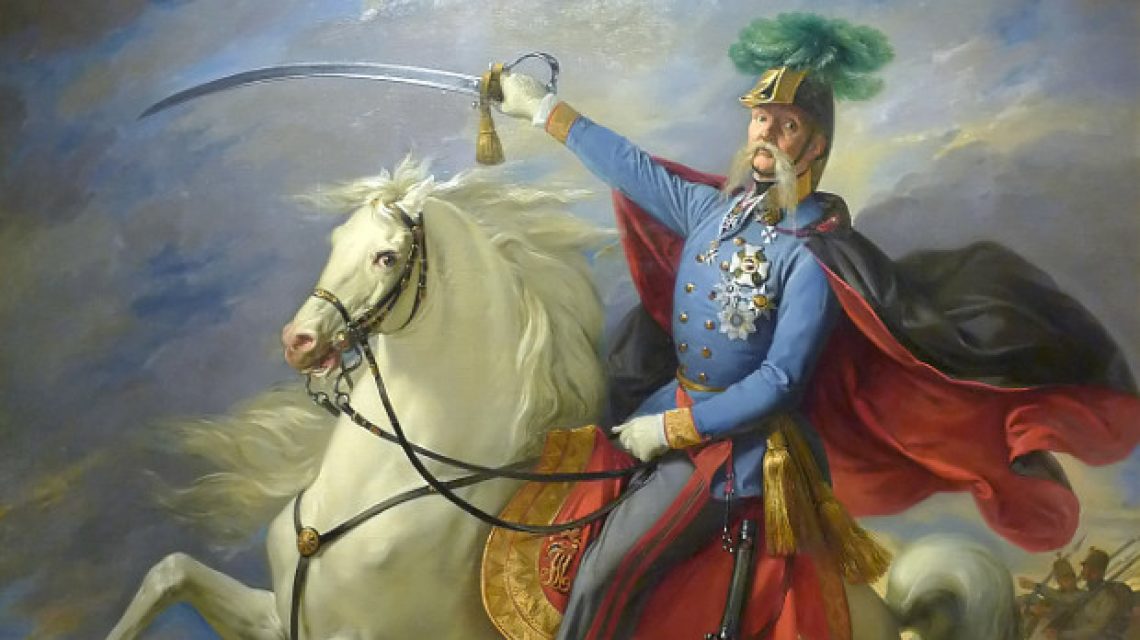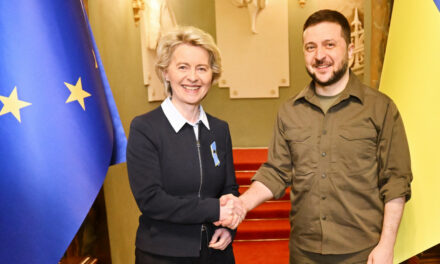"A nation that does not know its past does not understand its present, and cannot create its future!"
Europe needs Hungary... which has never let itself be defeated.
Haynau's Reign of Terror (1849-1850)
“I am the man who will clean up. I shoot hundreds dead with a clear conscience, because I am firmly convinced that this is the only way to set a warning example for all future revolutions." Haynau, sworn enemy of the Hungarians, testified.
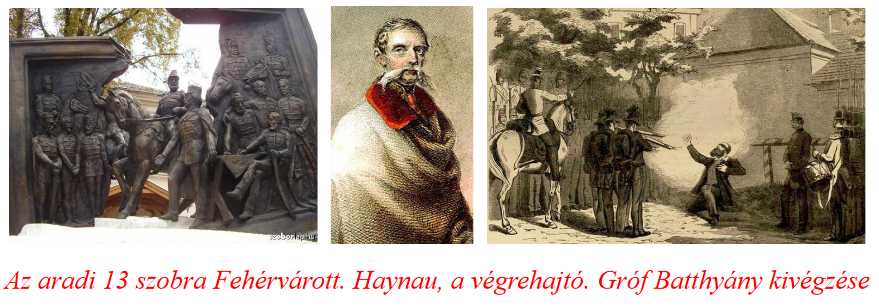
The hyena of Brescia, as Haynaut was called, did not let go of his strictness and his hatred of the Hungarians even after the defeat of the war of independence. 600 death sentences until 1850 , of which 150 were carried out. 1,200 people were imprisoned , and approximately 50,000 men were sentenced to conscription. The reign of terror lasted for 11 months, until July 6, 1850. Ferenc József felt that he had taken satisfaction for the April 14, 1848 dethronement. He expressed this by firing Haynau. European public opinion also played a role in his decision, which increasingly condemned the bloodshed of the Habsburgs.
The Bach System (July 1850 – August 1859)
The regime of Alexander Bach, the Minister of the Interior, which lasted for nine years, did not give up the autocratic rule over the Hungarians, but softened the methods of the Haynau terror. Until 1860, after Haynau, Archduke Albert of Habsburg-Teschen was officially the governor of the country, but the real power was already exercised by Bach.
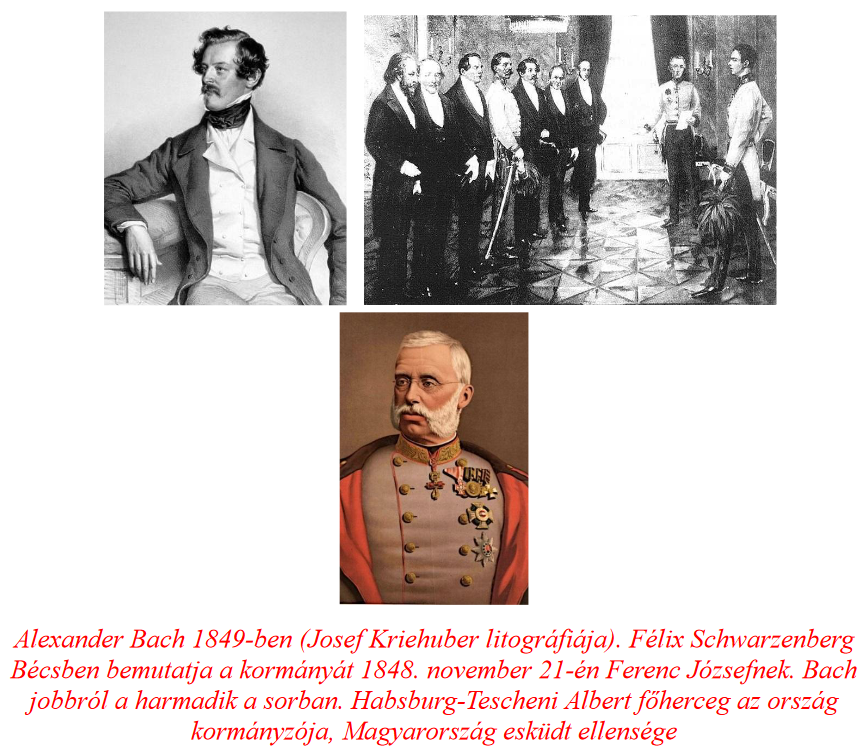
The main goal of the Court is to integrate Hungary into the empire. The first step on the way to this was the reorganization of the public administration. (Previously, József II, the "King in the Hat", also tried to break up the county system and divide the country into ten districts, but he didn't succeed either.) In addition, the self-government of cities and counties was abolished. The language of public administration became German, which the Viennese court had already tried several times before.
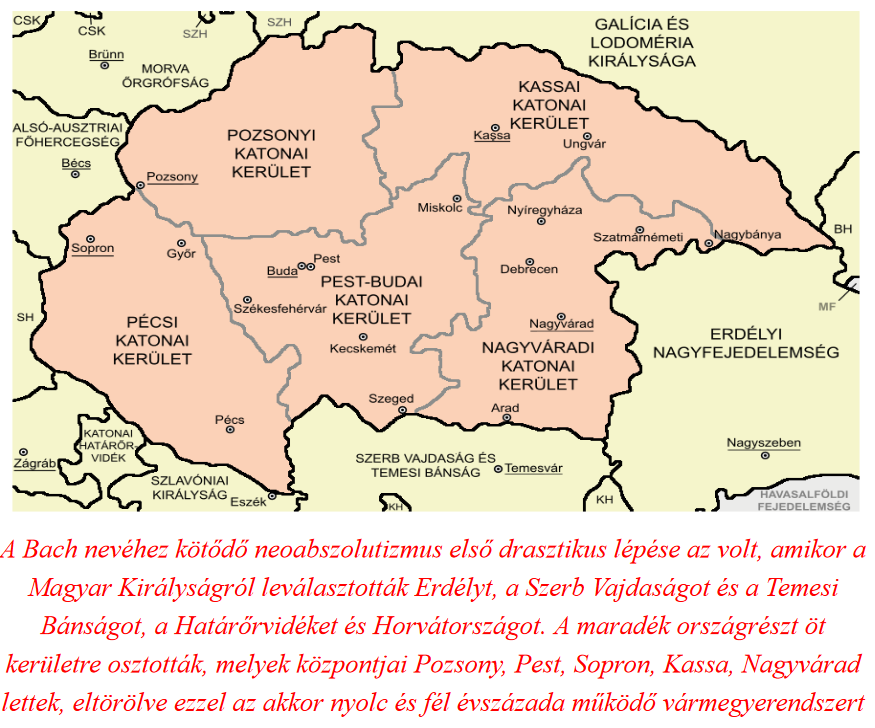
In addition to the territorial reorganization, the new clerical system was also introduced, which was embodied by the so-called Bach Hussars. In the offices, each task was performed by two officials, because in addition to the Hungarian-speaking official, if there was one, an Austrian official also worked. This dual system of officials was necessary so that the loyal man of Vienna could control the Hungarian, although the latter could not deny Habsburg interests either. Furthermore, many Austrian officials were put in charge of the districts because many of the Hungarians who had served before were not willing to serve the regime of Ferenc József. However, this meant double the cost for the Court, which made the operation of the machine difficult.
It is worth making a small digression on the activities of Baron Johann Kempen, who already played an important role in the revenge campaign against the Hungarian War of Independence in 1849. Kempen, the newly appointed Minister of Police - it is no coincidence that the appointment was made at the suggestion of Haynau - was the one who ordered the execution of Lajos Batthyány by bullet instead of hanging. Among his important tasks was the tenacious search for the Holy Crown, which was successful with the help of one of his Hungarian agents, István Wargha. He called Kossuth a common criminal, a thief, for daring to act against the emperor and for taking the Holy Crown with him. (István Wargha was one of the most diligent informers of the Austrian system, among other things he was "thanks" to the capture of the freedom fighter Gáspár Noszlopy from Somogy.)
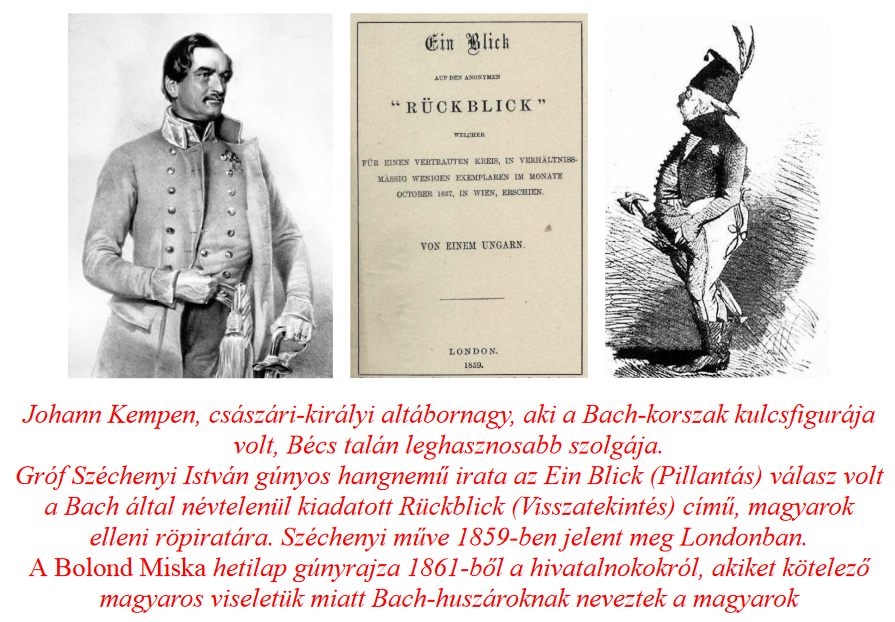
Kempen's name is associated with espionage against Count István Széchenyi, who lived in Döbling, and who resumed political activity in the second half of the 1850s. Kempen's scouting work was successful, as he chased Széchenyi to his death on Easter 1860. The police minister's anger was understandable, since Széchenyi exposed and spread abroad the false propaganda policy of the Viennese court against Hungary. (For example, he sometimes sarcastically referred to Bach as Pataki in his writings.) Under Kempen's control, the Habsburg machine built a police and intelligence network that was unprecedented in almost all of Europe.
The two-faced Hungarians
Perhaps, starting from the example of István Wargha, we should note that in Hungarian history there have always been those who changed owners out of self-interest, money, fear, or succumbing to blackmail. This was already the case in the Árpád era, when some of the 23 kings belonging to the Turul dynasty (Péter Orseolo, Német (I.) András, Solomon, András III) requested the help of the German-Roman emperor. The following series of pictures depict the prominent Hungarian kings, generals, and politicians who represent the "torch-bearers" of the 1,100-year-old Hungarian history. The descendants who followed them, for whom they were role models, embody Hungarian history.
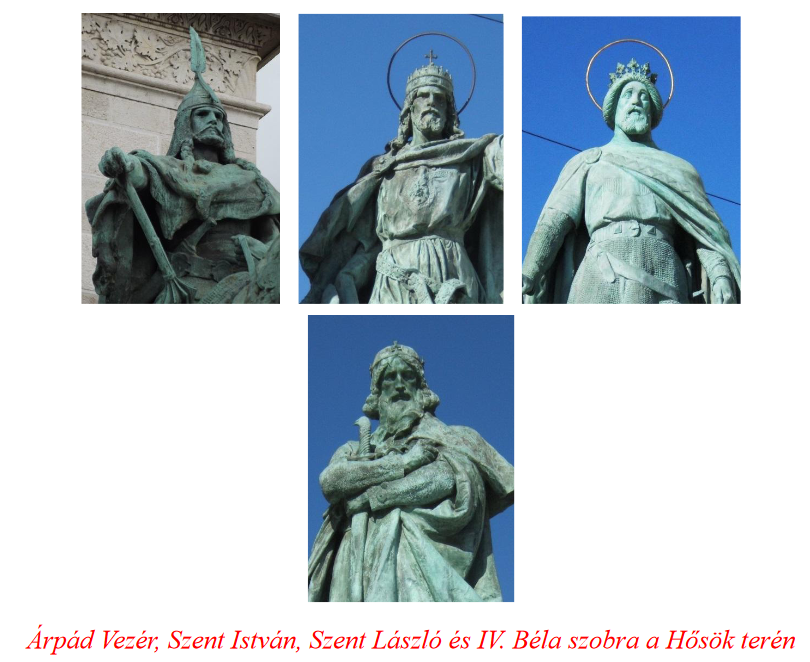 The kings of Anjou - although they were foreigners - we consider them among our greatest kings. But even in their time, they had to fight against the Hungarian lords who betrayed the country and played the crown into foreign hands. This also characterized the half-century reign of Emperor Sigismund and the Hungarian king, but the Hunyadi people also had to fight internal and external enemies.
The kings of Anjou - although they were foreigners - we consider them among our greatest kings. But even in their time, they had to fight against the Hungarian lords who betrayed the country and played the crown into foreign hands. This also characterized the half-century reign of Emperor Sigismund and the Hungarian king, but the Hunyadi people also had to fight internal and external enemies.
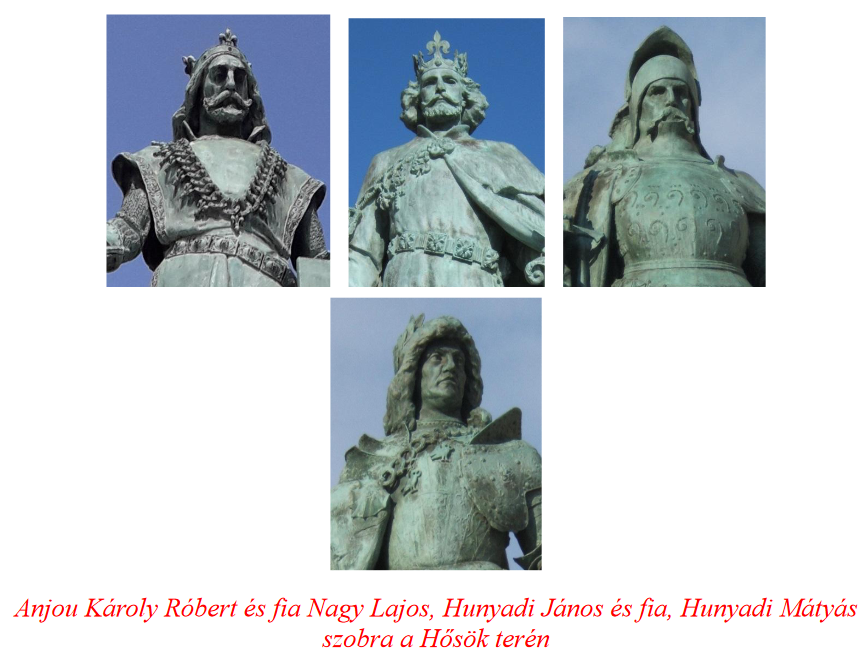
After the capture of Mohács and Buda, the country was divided into three parts. In all three parts of the country, there were a good number of Hungarians who changed language, soul, and owner, often just to stay alive. This is indicated by sharp contradictions, betrayals and surprising turns within the Principality of Transylvania. The territory of Hódoltság was more characterized by the Hungarian genocide, the disappearance of hundreds of villages and towns, and the depopulation of agricultural areas. The Hungarians of Royal Hungary aligned themselves with the will and interests of Vienna. Despite this, or perhaps precisely because of this, the Kuruc freedom wars started from here.
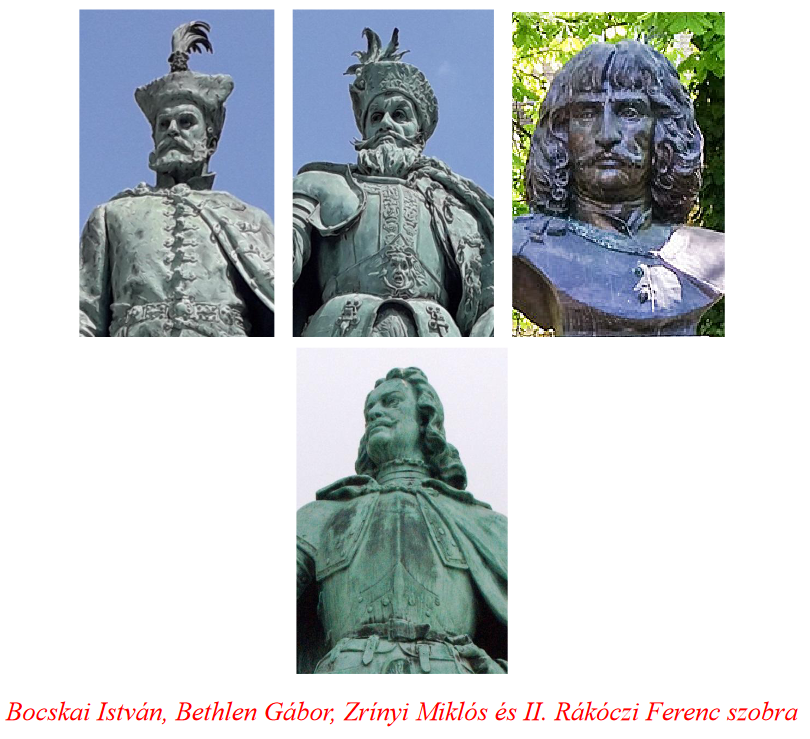 Imre Thököly, Ilona Zrínyi, then the II. Freedom wars led by Ferenc Rákóczi also divided the country's population. In addition to the Kurucs who fought for Hungarian freedom, there were quite a few Hungarians who served the emperor with their knowledge, money, and weapons. They were the boys.
Imre Thököly, Ilona Zrínyi, then the II. Freedom wars led by Ferenc Rákóczi also divided the country's population. In addition to the Kurucs who fought for Hungarian freedom, there were quite a few Hungarians who served the emperor with their knowledge, money, and weapons. They were the boys.
The great transformation of the country in the 18th century - which was determined mostly by the four-decade reign of Mária Theresia - revived Hungarian virtue and the desire to restore the country's unity. The reform era, the political battles of the Bratislava Diets, were followed by the 1848/1849. revolution and freedom struggle. This time, as in previous centuries and in the following century and a half, we were left alone. I like it, the Battle of Bratislava in 907 is not over yet. This is confirmed by the first Trianon that took place in 1920, then the 1947 peace of Paris that confirmed it, the second Trianon, and the tragic events that are taking place in Europe today, which I think of as the third Trianon.
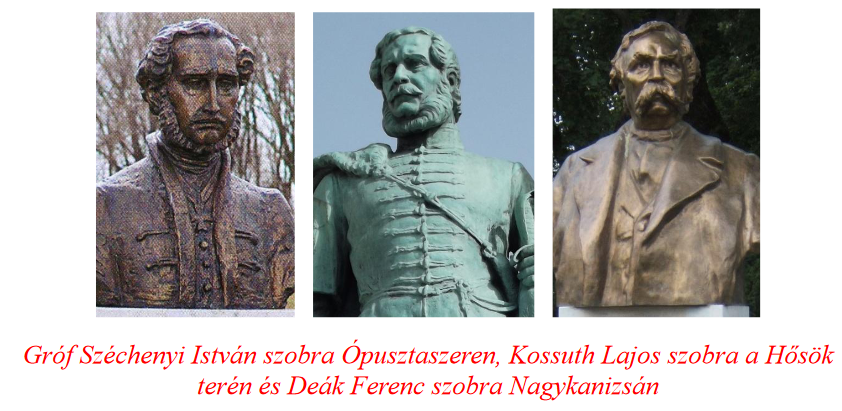
The First World War, which only we Hungarians did not want, ended in a heavy defeat for Hungary. Its tragic results include, among other things, the assassination of Count István Tisza, former Prime Minister, the reign of the Council Republic led by Béla Kun, who exterminated the Hungarian soul and people, and then the loss of two-thirds of the country. This was the already mentioned first Trianon, the great tragedy of the Hungarian people, which this people has not recovered to this day.
The Second World War once again destroyed what the man of the Horthy era was able to build from the truncated country. The foreign powers restored the borders of Trianon, and the biggest retort once again affected Hungary. It was the second Trianon. The Hungarian revolution and freedom struggle of 1956, which ended the Rákosi era, set a world-famous example of love of freedom and self-sacrificing behavior. The reward was the legalization of the Kádár era, which, in addition to Moscow, was accepted by Washington, Paris and London. Our country was lowered to the lowest point again, while Austria and Germany, which gave the world Hitler, were rewarded with Marshall aid, among other things. We were left alone again.
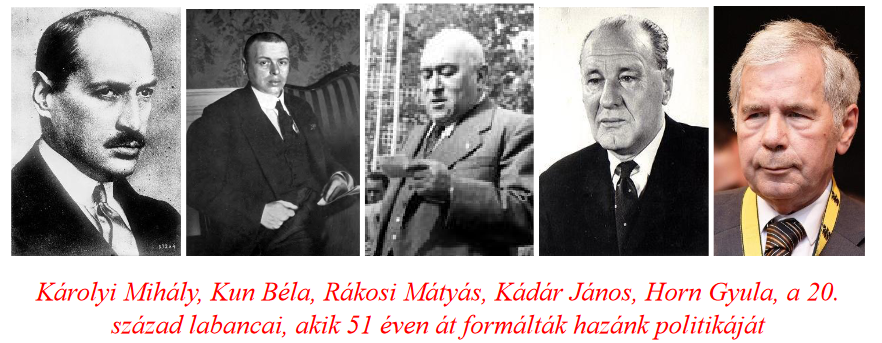
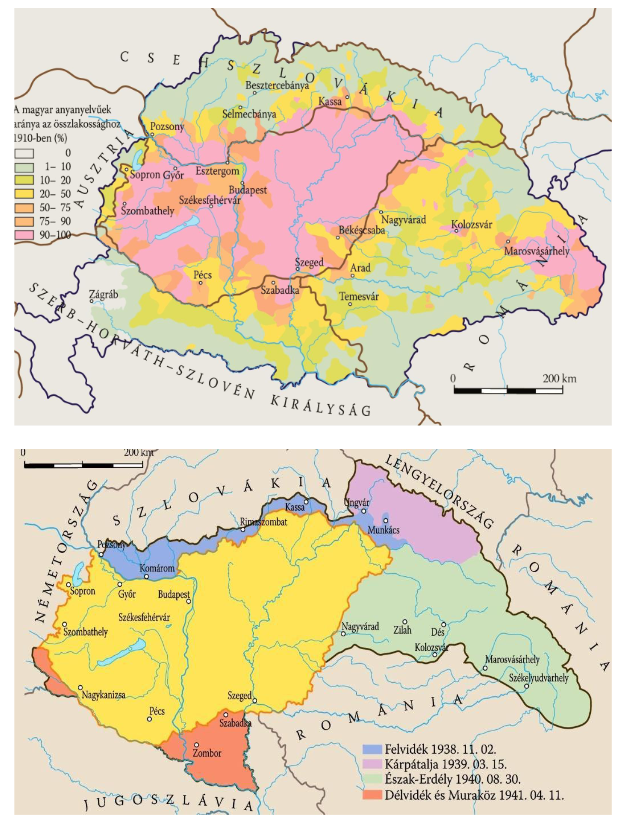
 The so-called regime change raised hope in the people of Hungary that we could finally live like the happier and luckier half of Europe, the West. It didn't happen that way. The soul-crushing Kádár system had its effect. It divided the people of the country to such a great extent that we could not recover from it even after 35 years. The decades between 1945 and 1990 caused similar divisions in the other socialist countries, but based on the experience of the last decades, only Hungary was left alone. This cannot be an accident, this is our destiny.
The so-called regime change raised hope in the people of Hungary that we could finally live like the happier and luckier half of Europe, the West. It didn't happen that way. The soul-crushing Kádár system had its effect. It divided the people of the country to such a great extent that we could not recover from it even after 35 years. The decades between 1945 and 1990 caused similar divisions in the other socialist countries, but based on the experience of the last decades, only Hungary was left alone. This cannot be an accident, this is our destiny.
The situation is not encouraging today either. In the past 35 years, there has been a sharp contrast between Hungarian citizens who align themselves with our historical, national values and accept Christianity - let's call them right-wing - and those who regard all these as secondary and prefer to accept global, foreign values - let's call them left-wing. However, it does not hurt to know that those who Árpád - Szent István - Lajos Nagy - János Hunyadi and Mátyás Hunyadi - István Bocskai - II. They follow the example of Ferenc Rákóczi - István Széchenyi - Lajos Kossuth, and they stand to win in this country. Who remembers the opponents of our listed historical greats? Because they were. Perhaps the listed Labanci of the 20th century are still alive in the Hungarian public consciousness, who knows how long. It's incomprehensible, but some people want the third Trianon.
An attempt to create a civil state
If it was not possible for the Hungarians to form their own civil state either in 1848 or 1859, then the people of Hungary had to live on the basis of Austrian practice and laws. Vienna abolished all the achievements of the reformation period, the laws of April 1848 and the war of independence. In 1850, the Court introduced public taxation, which generally meant a tax rate of 20%. In 1853, József Ferenc issued the lordship patent, which, in addition to the liberation of serfs, also provided for the compensation of the nobility, exceptionally taking into account part of the April laws. The modernization of agriculture also failed because compensation was delayed for many years. The rate of serfdom rose to 25%, which worsened the previous situation. Taxes became so high that many went bankrupt, unable to pay their loans. This is where the trick of creditors experienced in financial management – a practice known since ancient times and still unprecedented today – took place, when the indebted owner was extorted from all his assets.
One of the driving forces of urbanization was the shaping and transformation of the economy and culture, along with the world view. The attack against Christianity, which started from France, was given a prominent role. The movement of money started the industrial revolution, which then produced another significant amount of capital. This cultural and economic form also appeared in the Eastern countries of Europe, primarily in the Habsburg Empire and the countries belonging to it.
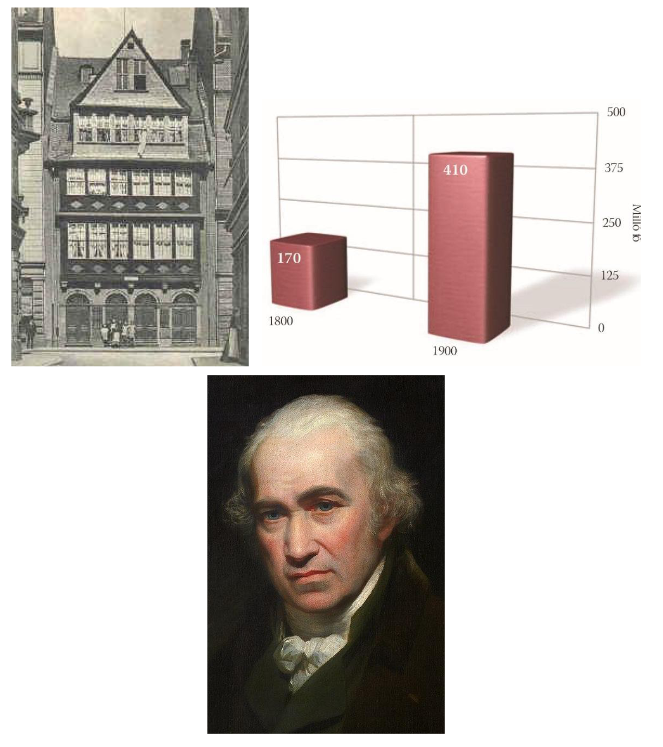
 Nathan Rothschild's biggest "investment" of the beginning of the 19th century was the last chapter of the wars against Napoleon, the Battle of Waterloo. The London-based bank financed the English and Prussians who lined up against Napoleon. The fabulous Rothschild fortune was accumulated based on the principle of information power. Rothschild built the courier service ahead of everyone else. Thus, in the summer of 1815, he was the first to hear the news of the Battle of Waterloo and Napoleon's defeat in London. The bank's courier was eight hours ahead of the victorious Duke of Wellington's courier service. These eight hours were enough for Rothschild to start selling government bonds on the London Stock Exchange, followed by most bond investors. When the prices fell to nothing, Rothschild's men bought back the papers for pennies. That's when the official messenger arrived, announcing Napoleon's defeat. The price of the bonds skyrocketed, but most of them were already owned by Nathan Rothschild. Among other things, the secret of the Rothschilds is to be found in such actions.
Nathan Rothschild's biggest "investment" of the beginning of the 19th century was the last chapter of the wars against Napoleon, the Battle of Waterloo. The London-based bank financed the English and Prussians who lined up against Napoleon. The fabulous Rothschild fortune was accumulated based on the principle of information power. Rothschild built the courier service ahead of everyone else. Thus, in the summer of 1815, he was the first to hear the news of the Battle of Waterloo and Napoleon's defeat in London. The bank's courier was eight hours ahead of the victorious Duke of Wellington's courier service. These eight hours were enough for Rothschild to start selling government bonds on the London Stock Exchange, followed by most bond investors. When the prices fell to nothing, Rothschild's men bought back the papers for pennies. That's when the official messenger arrived, announcing Napoleon's defeat. The price of the bonds skyrocketed, but most of them were already owned by Nathan Rothschild. Among other things, the secret of the Rothschilds is to be found in such actions.
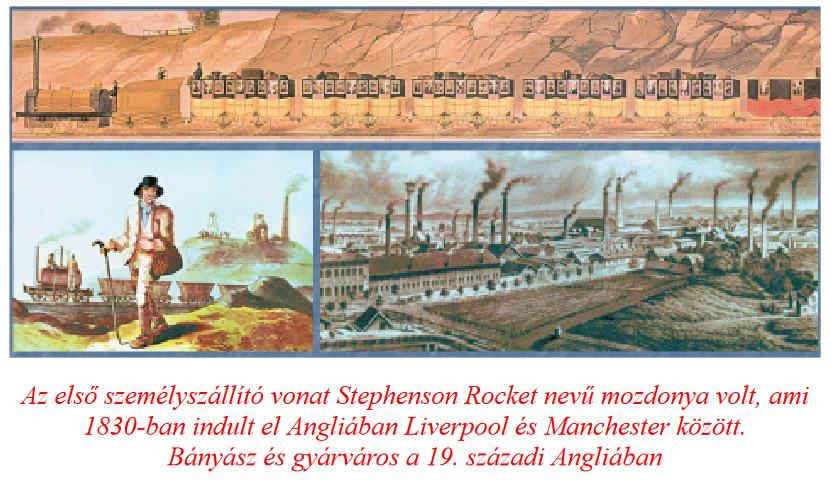
In the 19th century, a series of industrial, agricultural, cultural, and worldview changes came to Hungary from the Western countries of Europe. The pioneer was Count István Széchenyi himself, who sought and brought with him practical and theoretical solutions during his European travels, with which he wanted to serve Hungarian development. However, this required money, which he tried to obtain from Viennese banks and Austrian investors. He didn't even think that with this - among other things - he used the capital of the Rothschilds.
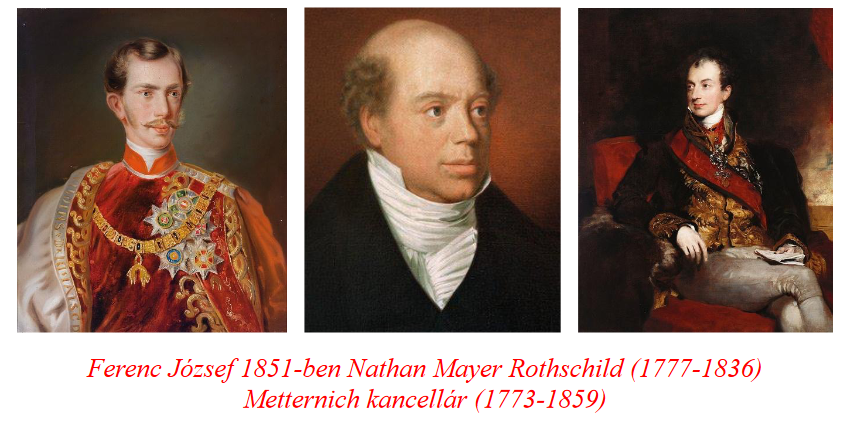 There is a reasonable suspicion that this is how the Viennese banking world managed to acquire high-quality Hungarian land. Already in the years before the War of Independence, the role of the Vienna Rothschilds in Austrian economic, political, and cultural life became apparent. For example, the Metternich loans /1827-1850/ exerted a decisive influence not only on events in Austria, but also in Hungary. Financial operations of greater importance then play a decisive role after the settlement, from 1868.
There is a reasonable suspicion that this is how the Viennese banking world managed to acquire high-quality Hungarian land. Already in the years before the War of Independence, the role of the Vienna Rothschilds in Austrian economic, political, and cultural life became apparent. For example, the Metternich loans /1827-1850/ exerted a decisive influence not only on events in Austria, but also in Hungary. Financial operations of greater importance then play a decisive role after the settlement, from 1868.
Citizenship the Austrian way
The Viennese court was in a state of split consciousness because it was receptive to Western economic and social patterns. But these restless, hard-to-break Hungarians did not make it easy for the Habsburgs, unlike the Czechs, Croats, and other peoples of the empire. They continued to punish, and they wanted to reshape the fate of Hungarians in their own image.
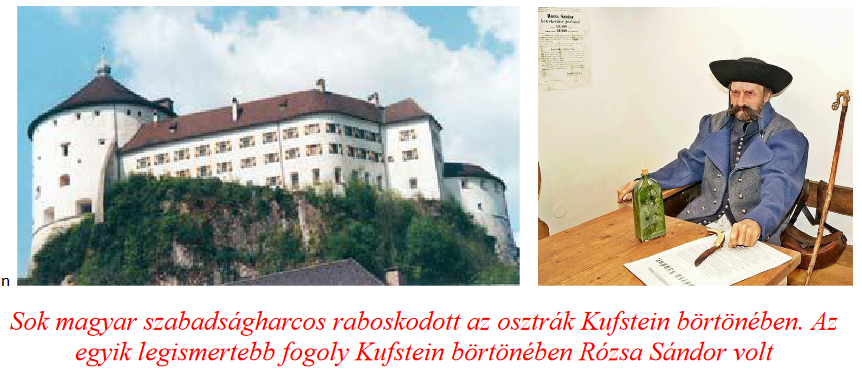
In 1853, the system of the Austrian criminal and civil code was introduced, which abolished Hungarian customary law from court practice. Vienna appointed the judges, which made it impossible for fair and impartial judgments to be made. The unified education system was introduced (eight-grade high school, baccalaureate, vocational teacher system, education in German). This laid the foundations of the so-called Prussian boarding school system. Furthermore, they introduced the Austrian unit of measure and tax system, which trampled Hungarian traditions.
The introduction of the civil transformation in the Austrian way did not preclude symbolic executions from being carried out even in these years. The executioner hung the names of Lajos Kossuth, Bertalan Szemere, Mór Perczel, Count Gyula Andrássy, László Madarász, Richárd Guyon and Count Kázmér Batthyány on a gallows, and as a sign of the death sentence, a stick was broken in front of each of them.
Passive resistance (1850-1859)
Many Hungarians could not accept the Bach system. The nobility was primarily hurt by the fact that the increased taxes were used to support officials and the armed forces. The nation could not think of armed resistance, so they chose a specific form of resistance. Those who claimed to be good patriots did not implement the decrees. He did not use the German language, he did not buy goods that benefited the oppressive system. Wherever possible, he hindered Vienna's politics and economic development. In particular, writers, poets, painters, sculptors, and composers did a lot for passive resistance. At the same time, this resistance flourished Hungarian art in a special way.
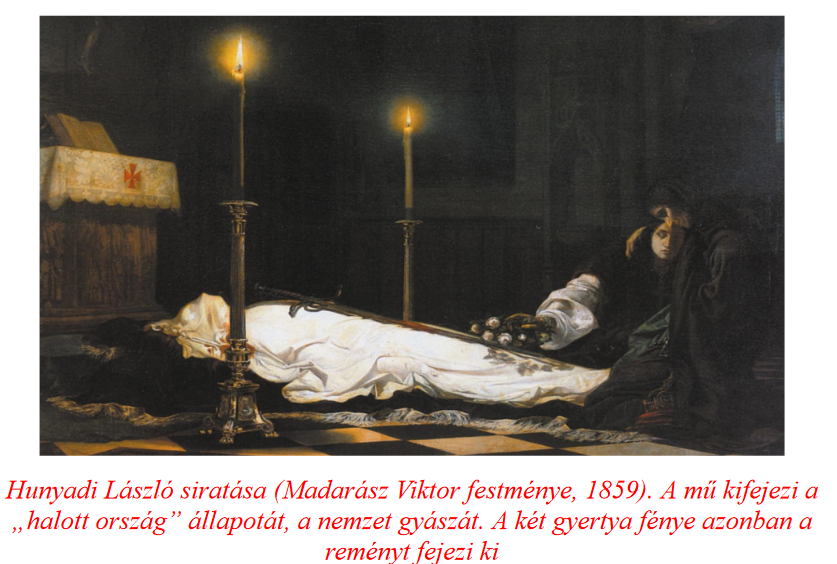
The great artists of the time referred to the historical events of long ago, but they did so in such a way that everyone felt and knew that it was actually about the Bach era. The paintings of Mihály Munkácsy, Miklós Barabás, József Borsos, Bertalan Székely, Mihály Zichy, the poetry of János Arany and Mihály Vörösmarty, the music of Ferenc Liszt and Ferenc Erkel, and the dramas of József Katona were only the tip of the iceberg.
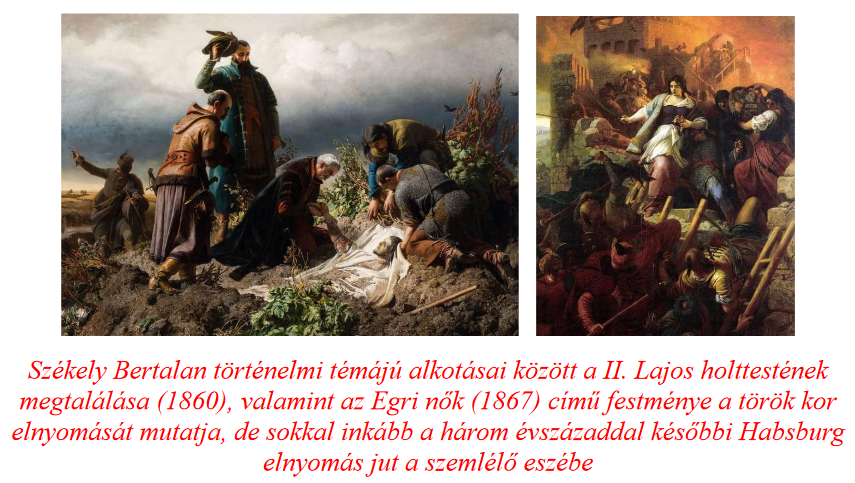
The resistance also manifested itself in such externalities as, for example, the frequent display of national colors, the growing of the Kossuth beard, Hungarian clothing, the use of the Hungarian language, the preservation of traditions, and the ostracism of Germans. In addition to passive resistance, in the fifties there were also some armed organizations and movements, and even an assassination attempt against József Ferenc. The organization of Gáspár Noszlopy, the conspiracy of József Makk in Székelyföld, the raids of Sándor Rózsa against the Austrian and Hungarian military troops allied with them, and
the assassination of the emperor by János Libényi in Vienna are worth mentioning.
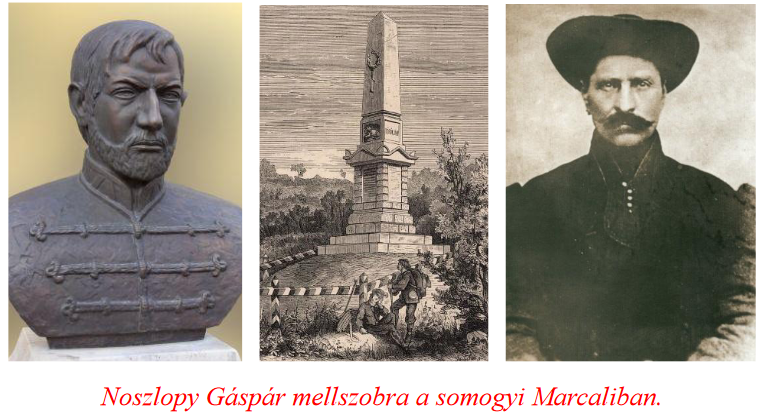
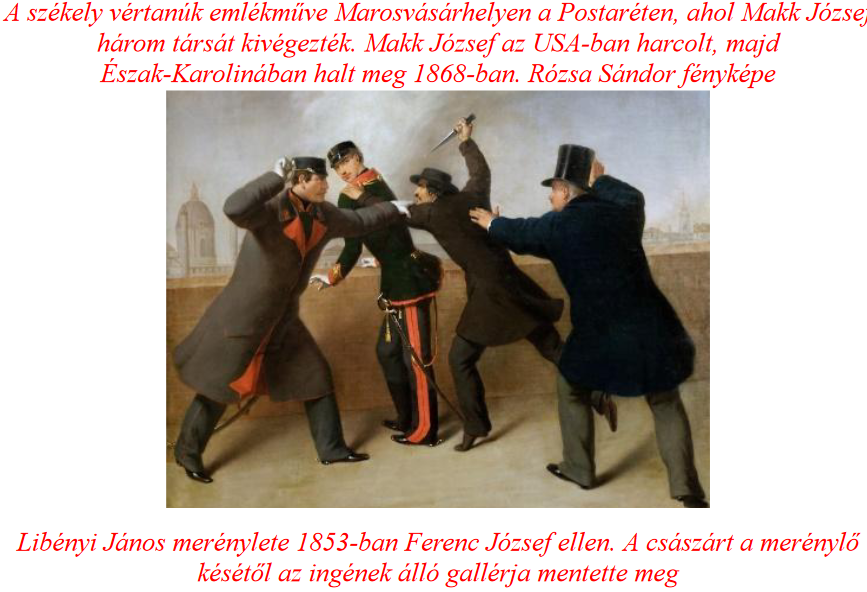 The Székely Vértanúk Memorial on Postarét in Marosvásárhely is the city's first public work of art, which has been in place since 1875. The three convicts (János Török, Mihály Gálffy, Károly Horváth) were executed on March 10, 1852, and then buried under the bitó trees. This day became the Székely Freedom Day, which the people of Székely still remember today, but not only in Székelyland. (In the motherland, the Székelyföldért Társaság holds the commemoration every year in Heroes' Square.)
The Székely Vértanúk Memorial on Postarét in Marosvásárhely is the city's first public work of art, which has been in place since 1875. The three convicts (János Török, Mihály Gálffy, Károly Horváth) were executed on March 10, 1852, and then buried under the bitó trees. This day became the Székely Freedom Day, which the people of Székely still remember today, but not only in Székelyland. (In the motherland, the Székelyföldért Társaság holds the commemoration every year in Heroes' Square.)
The diverse emigration
Many people emigrated from Hungary, thus expressing their opposition to imperial aspirations. There were those who saved their lives, there were those who took part in foreign freedom wars. There were those who left hoping to return later, many tried to organize alongside Kossuth and other political and military leaders. Most of them fled to Turkey. However, under pressure from Vienna, the Hungarians had to leave Istanbul for remote, desolate places, where they did not stay long due to the harsh conditions.
Bertalan Szemere, László Teleki and Gyula Andrássy tried to find allies in Paris, György Klapka, Ferenc Pulszky and Sebő Vukovics in London, but with little success. Western politicians, kings, and artists undisguisedly followed the interests of Vienna.
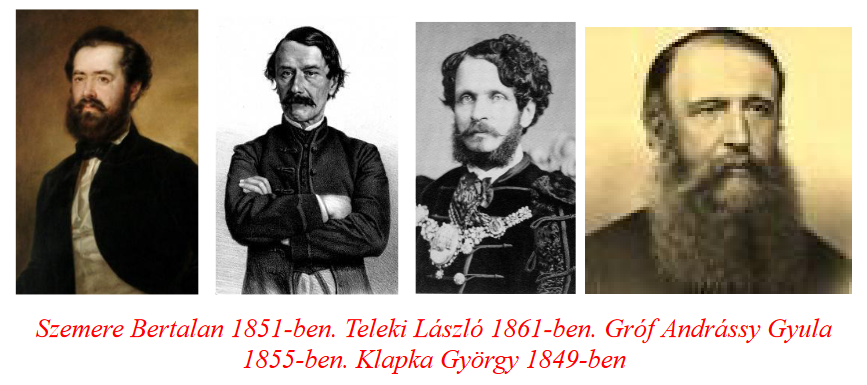
Despite their differences of opinion, Lajos Kossuth and László Teleki established the Hungarian National Directorate in 1858. Kossuth envisioned a Hungary that would separate from the Habsburg Empire, enter into an alliance with Croatia, Serbia and Romania, and create broad national autonomy. This idea matured by 1862, from which the unfortunately belated plan for the creation of the Danube Confederation was formulated.
Kossuth's trip to England and especially to America was one of the events of the emigration that aroused international interest. In September 1851, Kossuth and his companions left the increasingly oppressive Kütahya in Turkey and arrived in Southampton, England. They sailed across the Mediterranean Sea to the port city in England, where enthusiastic English celebrants welcomed the exiled Hungarians. You could tell even then, and this is true to this day, that there was never a shortage of words and celebrations, and there is no shortage today on the part of the Anglo-Saxons and other Western peoples, but even more so in deeds and help.
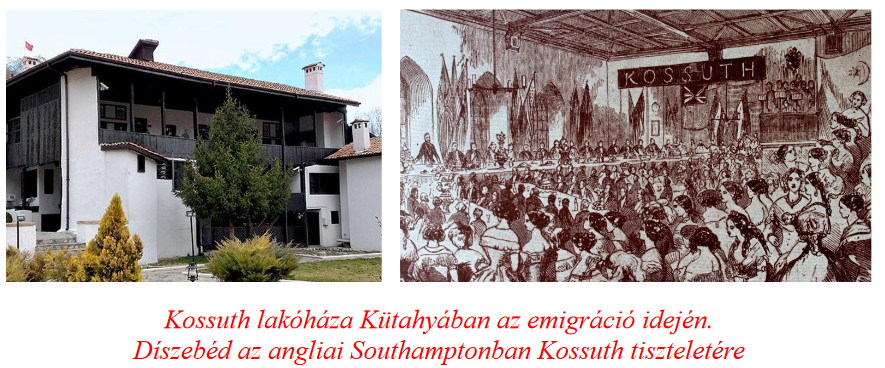
At the invitation of American President Milland Filmore, Kossuth and some of his companions arrived in New York in 1851 on the warship Mississippi, touching England. In America, the Hungarians were received with exceptional enthusiasm, and Kossuth was almost compared to George Washington.
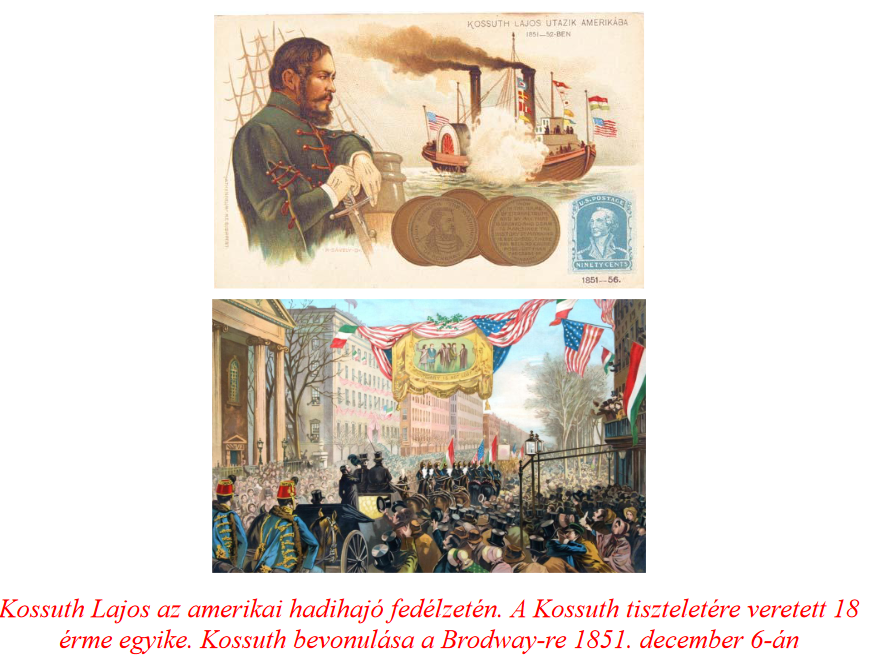
Returning to Europe, Kossuth negotiated III. With Napoleon, Count Cavour, the Prime Minister of Sardo-Piedmont, Garibaldi, the legendary Italian freedom hero. He organized the Hungarian Legion and sought foreign support. The Hungarian national guards fought in the Crimean War, in the Italian freedom movements and wherever they saw hope for Hungarian rebirth.
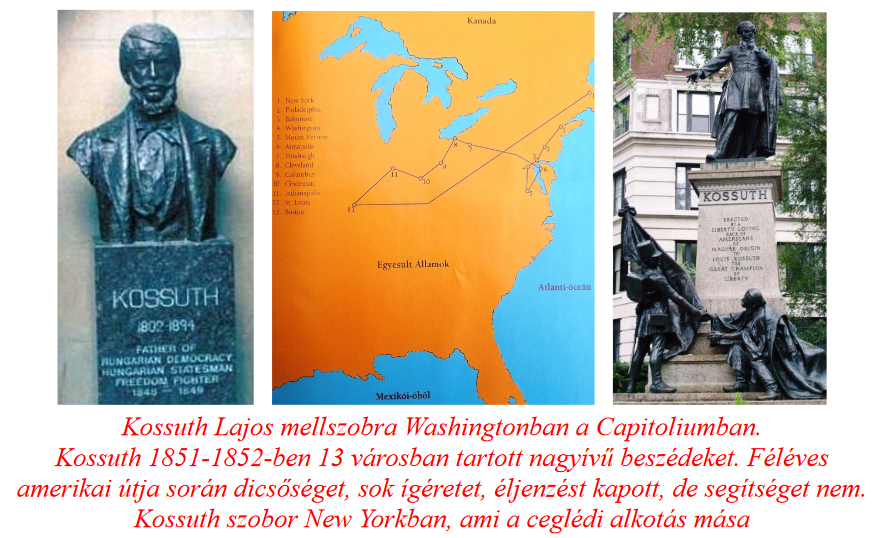
The numerous Western triumphal marches, the many negotiations with the French, Italian, and Anglo-Saxon leaders were flawed, and the Hungarian emigration plans were not in sync with the interests of the Western powers.
Ferenc Deák, the sage of the homeland
The most significant and successful figure of passive resistance was Ferenc Deák. The quiet, withdrawn Zala nobleman was the only one among the leaders of the Batthyány government and the freedom struggle - although he did not participate in the latter - who could play an openly political role even after 1849. Deák and his supporters stood by the laws of April 1848 and outwitted the absolutist aspirations with legal tactics. At the request of Deák's followers, he moved from his estate in Zala to Pest in 1854, where he found his final home in the English Queen Hotel. He obtained the money he needed to live in Pest from the sale of the estate in Kehida. Count István Széchenyi bought this from him in order to help Deáko in his activities. (He managed the operation from the sanatorium in Döbling, and his wife, Seliern Cresence, handled the purchase in Kehida.)
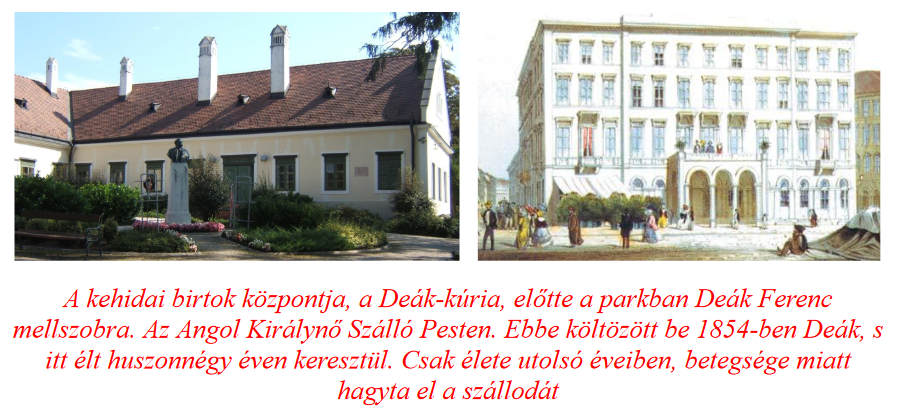
The fall of autocracy
Ferenc József needed ten years after the fall of the war of independence to realize that he would not have such an easy job with the Hungarians as with the Czechs, Croats, and other Slavic and Germanic subjects. Given that the power of the empire was wavering, he needed the Hungarians. Since Rudolf Habsburg, gullible Hungarians have saved the Austrian great power from its final fall in dozens of cases. (Just think of the rescue of Mária Theresa against the Prussians in 1841.) It is true that most of the wars of independence were fought against Hungary by the lords of Vienna, and even if they were successful thanks to their superior strength, Hungarian virtue was a constant problem for the kings of Bratislava. Mária Terézia handled the sensitivity of the Hungarians in the most clever way, and it was not without results.
In 1859, Austria faced external and internal difficulties, the first of which was the financial crisis. The economic difficulties were caused precisely by the operation of the Bach system, which consumed large costs. This was coupled with the serious military defeat that Austria suffered in the summer of 1859 in Solferino, Italy. (As an interesting point, I would like to mention one of the events of the Battle of Solferino, the consequences of which are still known to everyone today without exception. There were many wounded in the battle. Most of them could have survived, but they bled to death due to the lack of first aid. The Swiss doctor Henri Dunant was on the battlefield, and he was the first in the world to organize first aid The Geneva Convention in 1864 stated that first aid must be provided to for the wounded, thus the Red Cross was formed. Thanks to Dunant, its flag became the opposite-colored version of the Swiss flag.)
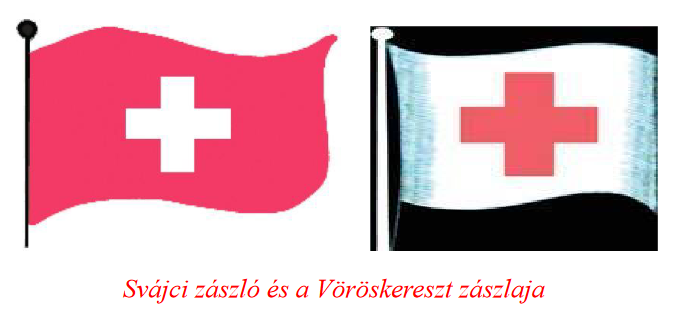
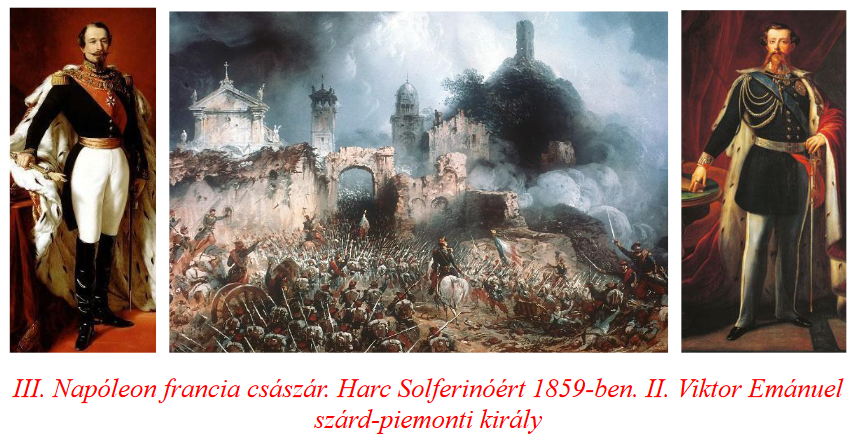 III. Napoleon's French and Piedmontese armies gained the rich Lombardy, and Joseph Francis lost the support of Czar Nicholas I. Russia submitted the bill for Vienna's failure to provide assistance to it in the Crimean War in 1859, which would have been its duty to return the campaign against the Hungarians ten years earlier. In addition, Austria had just received financial aid from England, for which it had to pay a doubly high price. On the one hand, in this historical situation, England was Russia's enemy, and on the other hand, Vienna committed itself to helping the Rothschilds. Not the first time and not the last time. This led Ferenc József to the decision that he should stop imposing neo-absolutism, as he needed the Hungarians' help. The emperor deposed Alexander Bach in August 1859 and restored the constitutional system in Hungary.
III. Napoleon's French and Piedmontese armies gained the rich Lombardy, and Joseph Francis lost the support of Czar Nicholas I. Russia submitted the bill for Vienna's failure to provide assistance to it in the Crimean War in 1859, which would have been its duty to return the campaign against the Hungarians ten years earlier. In addition, Austria had just received financial aid from England, for which it had to pay a doubly high price. On the one hand, in this historical situation, England was Russia's enemy, and on the other hand, Vienna committed itself to helping the Rothschilds. Not the first time and not the last time. This led Ferenc József to the decision that he should stop imposing neo-absolutism, as he needed the Hungarians' help. The emperor deposed Alexander Bach in August 1859 and restored the constitutional system in Hungary.
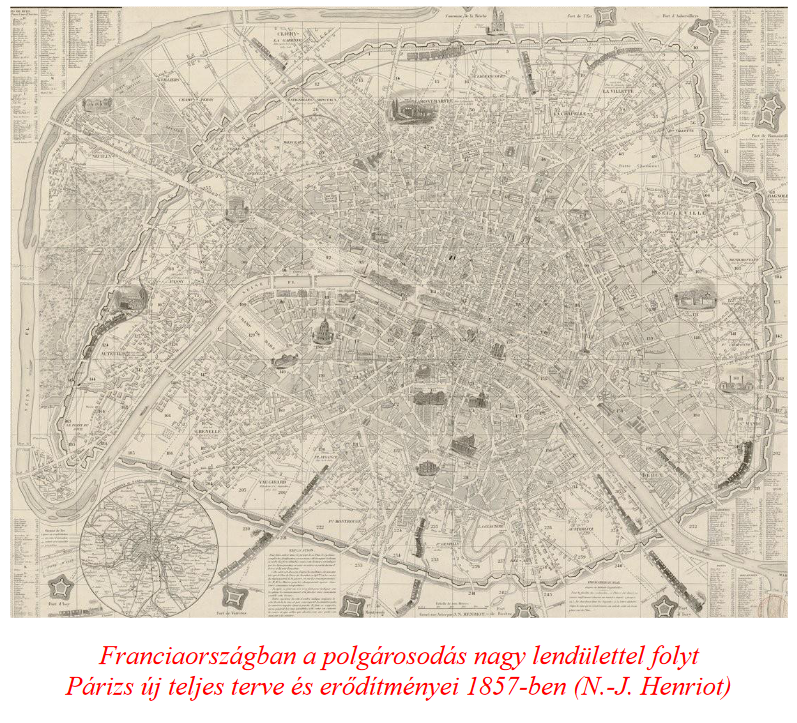
Author: Ferenc Bánhegyi
The parts of the series published so far can be read here: 1., 2., 3., 4., 5., 6., 7., 8., 9., 10., 11., 12., 13., 14., 15., 16., 17., 18., 19., 20., 21., 22., 23., 24,, 25., 26., 27., 28., 29/1.,29/2., 30., 31., 32., 33., 34., 35., 36., 37., 38., 39., 40., 41., 42., 43., 44., 45., 46., 47., 48., 49., 50., 51., 52., 53., 54., 55., 56., 57., 58., 59., 60., 61. 62., 63., 64., 65., 66., 67., 68.

